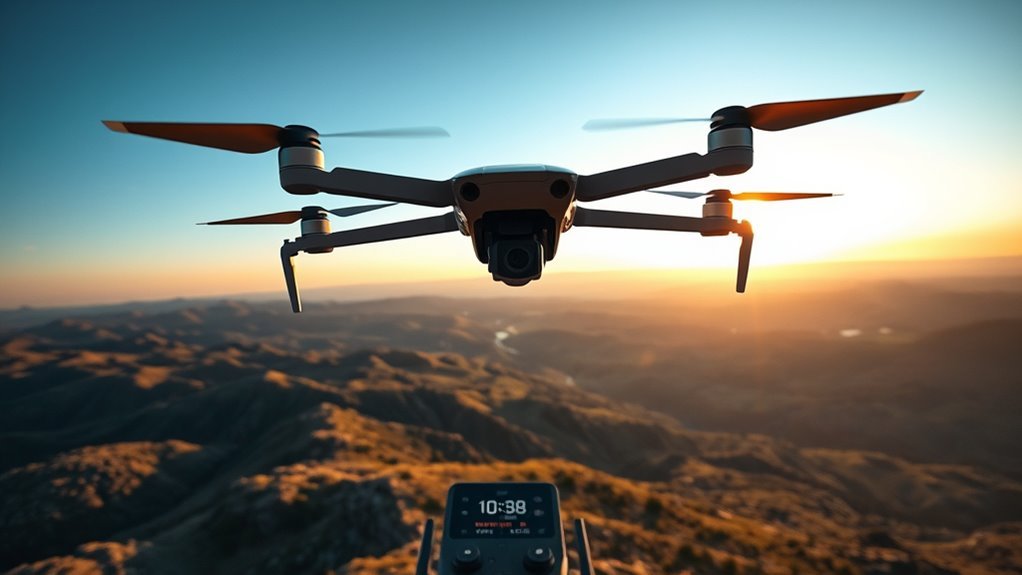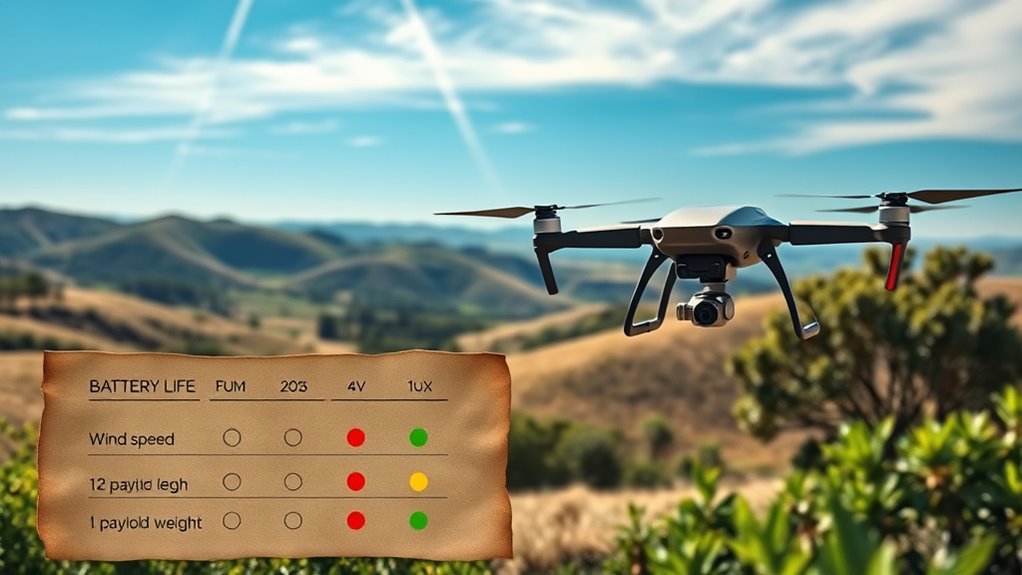Several factors determine how many miles drones can fly, including battery life and capacity, which affect energy consumption. The payload weight impacts energy use and flight stability. Weather conditions, like wind or rain, can alter performance and range. Aerodynamic design enhances efficiency, while advanced technology and control systems optimize flight paths. Finally, regulatory restrictions dictate where drones can operate. Understanding these elements can greatly influence operational planning and efficiency, leading to optimized flight capabilities.
Battery Life and Capacity

When considering drone flight miles, battery life and capacity play an essential role in determining how far you can fly. The choice of battery chemistry types—like lithium-polymer or lithium-ion—affects energy density and discharge rates, ultimately influencing flight duration. Higher capacity batteries offer extended flight times, but they can add weight, impacting your drone’s efficiency. Additionally, the availability of charging infrastructure can greatly affect range. If you’re in an area with ample charging stations, you can maximize your drone’s potential, allowing for longer missions without worrying about battery depletion. Consequently, understanding these dynamics is vital for planning your flights and ensuring you can explore freely, without the constraints of limited battery life and inadequate charging options. Furthermore, proper power management can optimize energy consumption, extending your drone’s operational distance. The energy efficiency of motors and flight algorithms can significantly reduce power consumption, further enhancing your drone’s range.
Payload Weight and Its Impact

When you’re operating a drone, understanding payload weight is vital for optimizing flight performance. Exceeding payload capacity limits can lead to increased battery consumption rates and negatively affect flight stability. Consequently, it’s important to balance payload requirements with the drone’s specifications to maximize efficiency. Proper payload distribution can minimize drag and enhance stability, further improving flight performance. Additionally, weight capacity constraints must be strictly adhered to, as failure to do so can strain propulsion systems and impact overall flight capabilities.
Payload Capacity Limits
Payload capacity is a critical factor influencing a drone’s flight miles, as it directly impacts performance and efficiency. When you consider payload distribution, you’ll realize that how weight is balanced affects stability and control. Different cargo types can considerably alter a drone’s aerodynamics, leading to variations in flight duration and distance. Heavier payloads often lead to increased energy consumption, which in turn limits the range. Understanding your drone’s payload limits guarantees you optimize for both the weight of the cargo and the desired flight distance. Choosing the right combination of cargo types while adhering to these limits can enhance your drone’s capabilities, allowing you to maximize its operational range without compromising performance.
Battery Consumption Rates
The relationship between payload weight and battery consumption rates is significant in determining a drone’s operational efficiency and flight range. When you increase the payload, the drone requires more energy to maintain lift, which directly impacts battery efficiency. This increased energy demand leads to faster depletion of battery resources, reducing overall flight time. Effective energy management becomes essential; you’ll need to balance payload weight with the drone’s capacity to optimize performance. By strategically planning your payload, you can enhance battery life while maximizing operational range. Understanding these dynamics allows you to make informed decisions, ensuring that your drone can cover more miles without compromising its battery performance or succumbing to premature energy loss. Prioritizing efficiency will grant you the freedom to explore further.
Flight Stability Considerations
Although flight stability is often overlooked, it is vital to understand how weight influences a drone’s performance. When you add payload, you’re not just increasing mass; you’re impacting the drone’s ability to maintain stable flight. Heavier loads can lead to reduced maneuverability and longer stopping distances, especially during altitude variations. This means the drone may struggle to adapt to changing conditions, risking instability. As a result, you’ll notice shorter flight distances due to increased energy consumption needed to counteract instability. Balancing the payload is important; it allows for the best flight stability, ensuring your drone can navigate efficiently without compromising its range. Evaluate your payload carefully to maximize your drone’s potential and enjoy that freedom of flight.
Weather Conditions and Their Effects

When considering drone flight miles, weather conditions play an essential role in determining operational efficiency and safety. You’ll find that factors like temperature effects and precipitation impact can greatly limit your drone’s performance.
- High temperatures can reduce battery life, impacting your flight range. Additionally, extreme temperatures can lead to battery capacity degradation, further limiting your drone’s distance capabilities.
- Rain or snow can hinder visibility and affect the drone’s sensors, reducing operational effectiveness.
- Wind speed can drastically alter the drone’s energy consumption, resulting in shorter flight distances.
Additionally, understanding aerodynamic design is crucial, as it can help mitigate some of the negative effects of adverse weather conditions on flight performance.
Understanding these elements is important for maximizing your drone’s capabilities. By monitoring weather conditions, you can make informed decisions that enhance your flying experience, ensuring that you’ll achieve peak results while enjoying the freedom that drone operation offers.
Drone Design and Aerodynamics
When considering drone design, the shape of the wings plays an essential role in determining aerodynamic efficiency. You’ll also need to account for the weight and materials used in construction, as these factors directly influence flight miles. By optimizing these design elements, you can markedly enhance performance and extend operational range. Additionally, the payload capacity of a drone significantly impacts its flight time and distance, as heavier loads can reduce overall efficiency. Furthermore, a drone’s aerodynamic design enhances stability and reduces air resistance, which is crucial for achieving longer flight distances.
Wing Shape Impact
The shape of a drone’s wings considerably influences its aerodynamic efficiency and overall flight performance. A well-considered wing design can enhance lift while minimizing drag, allowing for greater distances and improved stability.
- Aspect Ratio: Longer wings can increase lift-to-drag ratio, enhancing efficiency.
- Wing Shape: Variations like elliptical or tapered designs can optimize airflow, reducing turbulence.
- Wing Area: A larger wing area can provide more lift but may increase drag, necessitating a balance.
Weight and Materials
Although a drone’s aerodynamic performance is often attributed to its wing design, the weight and materials used in its construction play a crucial role in determining flight efficiency and distance. The choice of materials directly impacts the drone’s overall weight and material strength, affecting its ability to lift off and maintain stable flight. Lightweight materials, such as carbon fiber or advanced plastics, contribute to better weight distribution, allowing for enhanced maneuverability and longer flight times. Conversely, heavier materials can lead to increased energy consumption, limiting range. By optimizing both the drone’s weight and the materials used, designers can greatly improve performance, enabling you to explore greater distances without sacrificing stability or control.
Technology and Control Systems
As drone technology advances, the integration of sophisticated control systems becomes vital for enhancing flight distances. By employing advanced control algorithms and robust autopilot systems, you can improve your drone’s navigation accuracy and efficiency. These systems not only improve stability but also extend range by ensuring ideal energy consumption.
- Control algorithms adapt to environmental changes.
- Autopilot systems enable precise route management.
- Real-time data processing enhances decision-making, similar to how intelligent navigation tech optimizes paths for improved flight efficiency.
Moreover, drones like the Parrot Anafi AI exemplify advanced AI integration that optimizes flight paths and enhances overall performance. With these innovations, you can experience greater freedom in your drone operations. The ability to fly longer distances while maintaining safety and reliability is vital for various applications, from delivery services to aerial surveys. Ultimately, embracing these technologies empowers you to maximize your drone’s potential.
Regulatory Restrictions and Flight Zones
While maneuvering through the complexities of drone operations, understanding regulatory restrictions and designated flight zones is essential for optimizing flight miles. You’re likely aware that regulatory compliance can dictate the areas where you can legally operate your drone. These regulations often include no-fly zones around airports, military bases, and populated areas, limiting your range. To maximize your drone’s potential, you need to secure the appropriate flight permissions, which often involve submitting requests to authorities. Familiarizing yourself with local laws and airspace classifications can empower you to navigate these constraints effectively. By prioritizing compliance and understanding your flight zones, you can enhance your operational freedom while ensuring safety and legality in your drone flights.
Frequently Asked Questions
How Do Drone Maintenance Practices Affect Flying Distance?
Drone maintenance practices directly impact flying distance. If you prioritize battery health and increase maintenance frequency, you’ll enhance performance and longevity, allowing your drone to cover greater distances while ensuring reliability during your aerial adventures.
Can the Type of Terrain Influence Drone Mileage?
Yes, terrain challenges greatly impact your drone’s mileage. Maneuvering varied altitude effects can lead to increased battery consumption and reduced efficiency, ultimately limiting the distance your drone can cover in different environments.
What Role Do Pilot Skills Play in Flight Range?
Pilot skills greatly impact flight range. Experienced pilots utilize advanced flight techniques, optimizing altitude and navigation, which can extend a drone’s operational distance. Mastering these skills guarantees you’re maximizing efficiency and freedom in your aerial endeavors.
How Does the Drone’s Age Impact Its Performance?
Picture a well-worn drone, its battery lifespan dwindling. As drone technology evolves, age impacts performance considerably, reducing flight efficiency and range. Newer models often outperform older ones, offering greater freedom in the skies you crave.
Are There Specific Brands Known for Longer Flight Distances?
When exploring brand comparisons, some manufacturers consistently set distance records. Brands like DJI and Parrot often lead in flight range, offering models designed for peak performance, ensuring you experience that freedom to fly farther with confidence.

